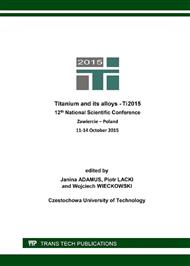[1]
Regulation of the Minister of Infrastructure and Development of 17th July 2015 amending the Regulation on technical criteria for buildings and their location (Journal of Laws 2013, item 926).
Google Scholar
[2]
A.B. Larbi, Statistical modelling of heat transfer for thermal bridges of buildings, Energy Build. 37 (2005) 945–951.
DOI: 10.1016/j.enbuild.2004.12.013
Google Scholar
[3]
S.A. Al-Sanea, M.F. Zedan, Effect of thermal bridges on transmission loads and thermal resistance of building walls under dynamic conditions, Appl. Energy 98 (2012) 584–593.
DOI: 10.1016/j.apenergy.2012.04.038
Google Scholar
[4]
K. Fukuyo, Heat flow visualization for thermal bridge problems, Int. J. Refrig. 26/5 (2003) 614–617.
DOI: 10.1016/s0140-7007(03)00006-9
Google Scholar
[5]
F. Asdrubali, G. Baldinelli, F. Bianchi, A quantitative methodology to evaluate thermal bridges in buildings, Appl. Energy 97 (2012) 365–373.
DOI: 10.1016/j.apenergy.2011.12.054
Google Scholar
[6]
C. A. Balaras, A. Argiriou, Infrared thermography for building diagnostics, Energy Build. 34/2 (2002) 171–183.
DOI: 10.1016/s0378-7788(01)00105-0
Google Scholar
[7]
A. E. Ben-Nakhi, Minimizing thermal bridging through window systems in buildings, Appl. Therm. Eng. 22/9 (2002) 989–998.
DOI: 10.1016/s1359-4311(01)00121-1
Google Scholar
[8]
M. Ibrahim, P. H. Biwole, E. Wurtz, P. Achard, Limiting windows offset thermal bridge losses using a new insulating coating, Appl. Energy, 123 (2014) 220-231.
DOI: 10.1016/j.apenergy.2014.02.043
Google Scholar
[9]
M. Sabry, P. C. Eames, H. Singh, Y. Wu, Smart windows: Thermal modelling and evaluation, Sol. Energy 103 (2014) 200-209.
DOI: 10.1016/j.solener.2014.02.016
Google Scholar
[10]
M. Tubielewicz-Michalczuk, The Influence of the architectural and landscape planning on the development of the public space in european cities, Advanced Materials Research, 1020 (2014) 669-673.
DOI: 10.4028/www.scientific.net/amr.1020.669
Google Scholar
[11]
D. Appelfeld, C. S. Hansen, S. Svendsen, Development of a slim window frame made of glass fibre reinforced polyester, Energy Build. 42/10 (2010) 1918-(1925).
DOI: 10.1016/j.enbuild.2010.05.028
Google Scholar
[12]
A. Gustavsen, S. Grynning, D. Arasteh, B. P. Jelle, H. Goudey, Key elements of and material performance targets for highly insulating window frames, Energy Build. 43/10 (2011) 2583-2594.
DOI: 10.1016/j.enbuild.2011.05.010
Google Scholar
[13]
B.P. Jelle, Traditional, state-of-the-art and future thermal building insulation materials and solutions–Properties, requirements and possibilities, Energy Build. 43/10 (2011) 2549-2563.
DOI: 10.1016/j.enbuild.2011.05.015
Google Scholar
[14]
J. Płoński, Defects of window installation, Build. Mater. 8 (2009) 33-36.
Google Scholar
[15]
Certification criteria for residential Passive House buildings, Passive House Institute, (2015).
Google Scholar
[16]
K. Mateja, Instruction 421 / ITB Installation of windows and balcony doors, (2008).
Google Scholar
[17]
J. Adamus, Applications of titanium sheets in modern building construction, Advanced Materials Research, 1020 (2014) 9-14.
DOI: 10.4028/www.scientific.net/amr.1020.9
Google Scholar
[18]
M. Peters, J. Hemptenmacher, J. Kumpfert, C. Leyens, Structure and Properties of Titanium and Titanium Alloys, in Titanium and Titanium Alloys, Red. Wiley-VCH Verlag GmbH & Co. KGaA, (2003) 1–36.
DOI: 10.1002/3527602119.ch1
Google Scholar
[19]
G. Welsch, R. Boyer, E. W. Collings, Materials Properties Handbook: Titanium Alloys. ASM International, (1993).
Google Scholar
[20]
O.C. Zienkiewicz, R.L. Taylor, The Finite Element Method: Solid mechanics. Butterworth-Heinemann, (2000).
Google Scholar
[21]
A. Derlatka, P. Lacki, Numerical analysis of temperature distribution in outside vertical compartment, Construction of optimized energy potential 1/13 (2014) 22-27.
Google Scholar
[22]
J. Montusiewicz, R. Drapała, Methodological remarks on the tridimensional modelling od carpentry work (in Polish), Advances in Science and Technology Research Journal 1 (2007) 92–100.
Google Scholar
[23]
G. Baldinelli, F. Bianchi, Windows thermal resistance: Infrared thermography aided comparative analysis among finite volumes simulations and experimental methods, Appl. Energy, 136 (2014) 250–258.
DOI: 10.1016/j.apenergy.2014.09.021
Google Scholar
[24]
S. Wiśniewski, T. Wiśniewski, Heat Transfer, 6. ed. Scientific and Technical Publishers (WNT), Warsaw-Poland, (2010).
Google Scholar
[25]
PN-EN ISO 9227: 2012- Corrosion tests in artificial atmospheres - Salt spray tests.
Google Scholar
[26]
J. Adamus, W. Gorecki, P. Lacki, Galvanised sheets as building material, Advanced Materials Research, 1020 (2014) 15–20.
DOI: 10.4028/www.scientific.net/amr.1020.15
Google Scholar


